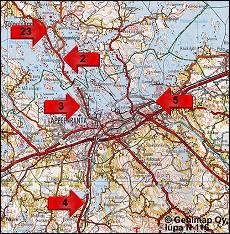
|
|
Site Map: Sites 2-5
|
23. Stone-Age burial ground and dwelling site at Vaateranta in Taipalsaari
The first inhabitants settled at Vaateranta during the Stone Age, some 7000 years ago. People lived there for 5000 years, right up to the Early Metal Age. The dwelling site was discovered in 1929. In 1970 we obtained the first indications of the red ochre graves. Studies that followed the findings determined that there is a Stone-Age burial ground at the eastern end of the settlement. Today the burial ground is the only one known of its kind in South Karelia. It was studied periodically from 1970 to 1999. No sign of the graves and dwelling site can be seen from the surface of the ground.
In an area of about 200 square metres, 22 graves have been found in the burial ground, of which six may be children's graves. It appears that the dead were lowered on their backs into graves dug in the sand, and red ochre was sprinkled over them. Items were also buried with the dead for their use: jewelry made from amber and slate, flint arrowheads, other stone utensils and, exceptionally, from one grave, three clay vessels. Only the teeth or dental enamel remain of the deceased.
The inhabitants of Vaateranta lived by capturing food, especially by fishing. There are also indications of farming at a later settlement phase. The settlement area forms a belt about 300 metres long in the direction of the water and extends to many individual homes.
Driving directions: Take Taipalsaarentie road (no. 408) from the centre of Lappeenranta and drive towards Taipalsaari for about 9.5 km. Turn right onto Jauhialantie road towards Saimaanharju ridge. Continue about 300 metres. The site is immediately beside the road on the right, by a swimming beach. Parking for cars or a bus.
